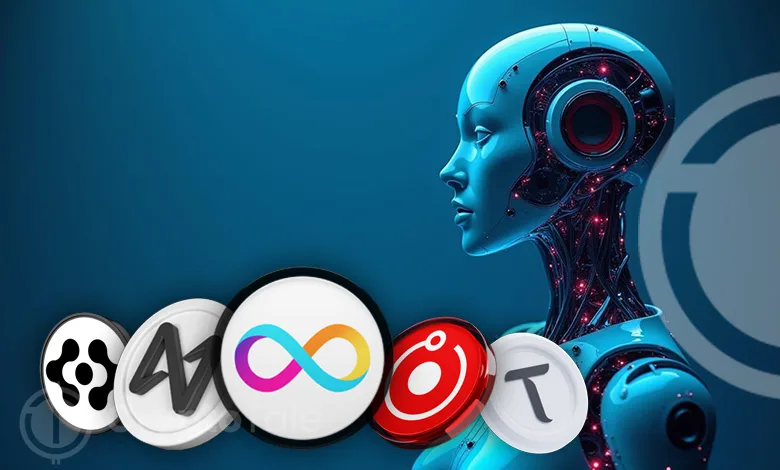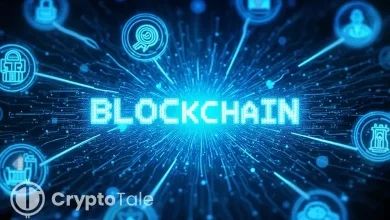Top 5 AI Tokens: Dev Powering Future Growth?

Artificial intelligence (AI) is making waves in the cryptocurrency market, paving the way for a new category of digital assets known as AI coins. These tokens combine AI’s computational power with the security and transparency of blockchain technology, creating a compelling proposition for both developers and investors.
In the fast-paced world of crypto, these AI-focused digital currencies are emerging as one of the most intriguing trends. This report explores the performance, market activity, and distinctive features of top AI coins: Bittensor, NEAR Protocol, Internet Computer, Render, and Artificial Superintelligence Alliance.
Top AI Crypto Coins
1. Bittensor (TAO)
Bittensor represents a novel approach to integrating AI with blockchain, positioning itself as one of the top AI coins in the market. This open-source protocol enables decentralized machine learning, allowing models to collaborate and earn TAO tokens based on their informational contributions. Bittensor aims to establish an open AI marketplace where developers can access and share AI models in a decentralized, transparent, and trustless environment. Its network consists of different nodes, including servers and validators, each rewarded based on their value contribution. High-value nodes earn more TAO, while low-value nodes face deregistration.
Over the past month, Bittensor’s token price has increased by 12.20%, closing at $407.11 at the time of publication. The 24-hour trading volume had dipped by 42.16%, reaching $104.28 million, while its market cap reached $3.56 billion. TAO recorded a 1.63% dip over the past 24 hours, yet it remains one of the top cryptocurrency projects, demonstrating consistent trading activity and growing interest in decentralized AI solutions. Its vision to decentralize AI development aligns with broader trends in blockchain innovation, making it a key player among AI tokens.
2. NEAR Protocol
NEAR Protocol has established itself as one of the leading Layer-1 blockchains in the decentralized applications (dApps) sector. It uses a Proof-of-Stake (PoS) mechanism, powered by its unique Nightshade sharding technology, to improve transaction speed, reduce fees, and handle higher transaction volumes. This sharding system splits the blockchain into smaller sub-chains, each managed by separate validators, enabling efficient transaction processing. NEAR also emphasizes user accessibility, offering human-readable account names and supporting app development through Web 2.0 programming languages like JavaScript.
According to data from CoinMarketCap, at press time, NEAR’s value has decreased by 1.94% to $2.42 over the last month, with a trading volume of $140.6 million. The coins’ price has declined by 14.40% in the last 7 days and increased by 0.79% in the past 24 hours. The token’s market cap stands at around $2.95 billion, reflecting its position among the best AI crypto coins and top Layer-1 projects. Trading for NEAR predominantly occurs on centralized exchanges, with Binance being the most active platform, followed by HTX and Upbit. The steady trading volume signifies ongoing investor interest in NEAR.
Related: Top 5 Game Coins: Building & Booming! Next Target?
3. Internet Computer
The DFINITY Foundation has reimagined blockchain technology with the Internet Computer. It wants to be the “World Computer,” supporting both Web3 and Web 2.0 applications. The Internet Computer can create smart contracts that can directly interact with other blockchains.
Developers can use this network to create decentralized services. It facilitates governance by compensating network participants and is considered to be one of the top AI and blockchain tokens. At the time of writing, ICP is trading at $4.92, an increase of 2.76% in its performance over the past month. It had a market cap of $2.62 billion and a 24-hour trading volume of $50.36 million. The blockchain’s ability to enable end-to-end decentralization makes it more appealing to developers.
4. Render
Render serves as a decentralized GPU compute platform supporting applications like 3D rendering, machine learning, and generative AI. It connects GPU node operators with developers seeking scalable rendering solutions, operating on a peer-to-peer model to maximize speed, scale, and cost efficiency. The Render Network Foundation leads this ecosystem, enabling artists and developers to build applications in the emerging digital economy. As a leading decentralized computing project, Render stands out among the best artificial intelligence cryptocurrency platforms.
At press time, Render’s is trading at $3.85, a decline of 17.91% over the last month. It has a 24-hour trading volume of $54.64 million and a market cap of $1.99 billion. The token experienced an increase of 0.66% in the last 24 hours. Render remains an essential component of the digital economy’s decentralized infrastructure, reflecting the growing demand for GPU-powered services.
5. Artificial Superintelligence Alliance
Arising from a merger of Fetch.ai, Ocean Protocol, and Singularity NET, the Artificial Superintelligence Alliance (ASI) attempts to build a decentralized network of AI using blockchain. It operates under the FET token and allows access to decentralized AI services and machine learning tools. FET tokens are offered on major exchanges, including WhiteBIT, Binance, and Bybit.
The trading volume of FET reached $112.71 million, a 9.02% increase at the time of writing. It saw a 7.64% increase in value from last month, bringing the price to $0.7489. With a market cap of $1.79 billion, it is positioned at 48th place. The alliance remains committed to open AI access, solidifying its position as a key contender.
Related: Top 5 Privacy Coins: Dev & Price Pump Incoming?
Conclusion
Bittensor, NEAR Protocol, Internet Computer, Render, and Artificial Superintelligence Alliance are just a few examples of blockchain innovation. Their use cases and market activities exemplify the diversity and adaptability of blockchain technologies in response to dynamic market dynamics. Nevertheless, each one has taken the project decentralization boundaries to a new level.





